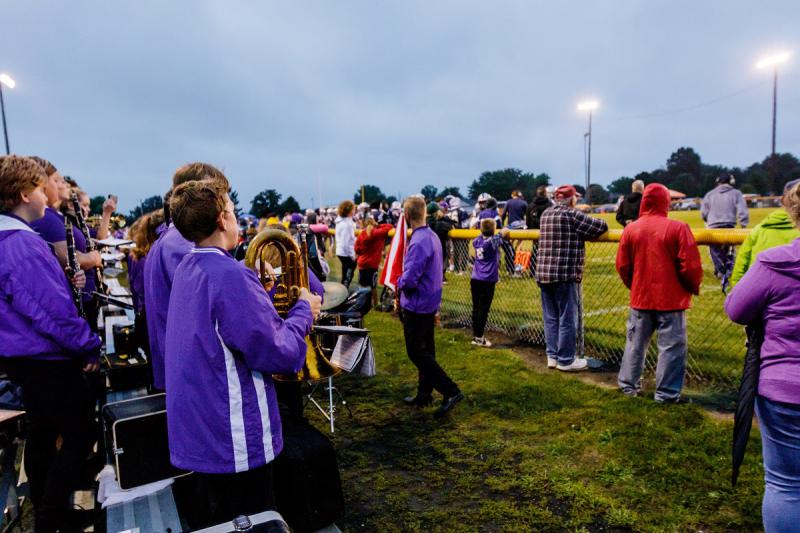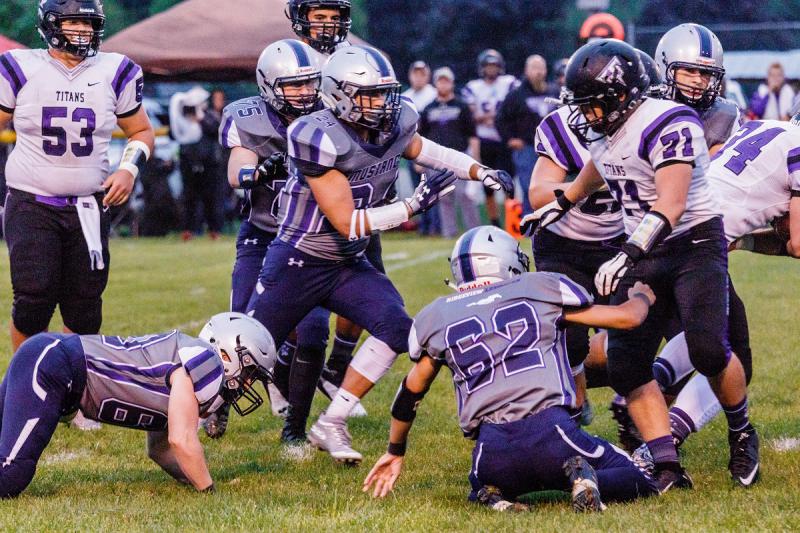As you drive into the small farming community of Lexington you quickly get a sense for the town’s pride in its school and its sports teams. A large sign off the main road trumpets its athletic achievements: 15 state championships in high school and junior high sports.

 The Lexington Marching Band performs during a Sept. 7 game.
The Lexington Marching Band performs during a Sept. 7 game.
Credit Jeff Smudde / WGLT
On a cold, windy and rainy night in September, fans from all over northern McLean County, including rival El Paso-Gridley, make their way to Lexington High School to take part in a Friday night ritual that’s as much religion as it is sport in much of America: high school football.
It’s a special night in Lexington because the football game their team is about to play against rival El Paso-Gridley is the only game Lexington will host all season.
That’s because Lexington no longer has a team of its own.
Six years after the Minutemen played in the state championship game, and four years after its star quarterback Alex Tanney was drafted into the National Football League (by the Kansas City Chiefs), the school which boasted five state title game appearances no longer had enough players to field its own team.
Participation in the sport has experienced a noticeable drop in recent years across the United States. Concerns about player safety and myriad socioeconomic factors raise concerns about the sport's long-term future especially in communities where the sport is so deeply rooted in its culture and traditions.
 Ridgeview-Lexington plays El Paso-Gridley on Sept. 7.
Ridgeview-Lexington plays El Paso-Gridley on Sept. 7.
Credit Jeff Smudde / WGLT
Eager to hold on to the sport, Lexington agreed to co-op arrangements with two consolidated school districts, Ridgeview based in Colfax and Blue Ridge-based in Farmer City. So students who wanted to play football had to ride the bus an additional 40 minutes each day—just to practice, just to have a football team.
The three-school co-op lasted just one season as Blue Ridge pulled out and now sponsors its own program.
Coach Jake Kennedy took over Ridgeview-Lexington in 2016 after three straight winless seasons at Ridgeview where he served as an assistant.
The job was open for three months and no one applied before the athletic director applied some pressure on him to take the job.
“Rodney (Kellar) had actually said to me, ‘Jake, if you take the head coach (position), I’ll be the offensive coordinator,” Kennedy recalled. “Well, I took the head job and he backed out as offensive coordinator.
“All kidding aside, he helped us for two years in the booth and helped us at some practices, but I’ll never let him live that down.”
"It is a tough sell in football now. That is the elephant in the room."
Edit | Remove
Despite dropping Blue Ridge from the co-op because the arrangement became too cumbersome, Kennedy has increased numbers in the Ridgeview football program. Ridgeview started the season with 53 players in all high school levels, with 16 of them from Lexington.
“The cliché is if you win, kids will come out. That’s not always true because we’ve only been 3-6 (last season),” Kennedy said. “I think if you get the right kids to come out, they’ll bring other kids with them and then there’s a vibe and there’s energy and your school is about ‘Hey, cool kids are playing football.'"
Kennedy added he has to allay concerns from parents who are worried about their child suffering a concussion.
“That could happen in basketball, it could happen in soccer, you could take a fastball to the head in baseball,” Kennedy said. “It if happens, it happens. It’s no different than a broken ankle or a broken leg doing any other sport.
“It is a tough sell in football now. That is the elephant in the room.”
While the co-op between former rivals has kept football alive in both communities, to some it still has diminished the community’s sense of identity.
“The fence-mending is like anything, you are going to have your established people that don’t want to see change,” Kennedy said. “You hope that if you sell it and kids are more taking part in it and the community comes together that that will go away, but it will never 100 percent be gone.”
Jamie Farrell is president of the Lexington Booster Club and was a cheerleader during her days at the high school. Her son played on the last Lexington football team as a freshman in 2014 but decided not to return after the co-op was formed.
“(We are) getting used to the new normal, getting used to the fact that Lexington doesn’t have a football team, that’s a challenge,” Farrell said. “It’s just tough right now but hopefully people are going to start buying into it more.”
As she helps set up food and drinks at the concession stand prior to kickoff, Farrell said she longs for the day that fans will see the Ridgeview-Lexington Mustangs as their own.
“People just aren’t coming out like they used to,” Farrell said. “I hope we can bring it back and people will get a little more used to it, more comfortable with it.”
The transition may be easier for some families who are less invested in the community’s past.
Polly Wolcott grew up in Peoria before moving to Lexington in 2000 to raise her children. Her son Tate plays on the football team and is a state champion long jumper.
She admits it was easier for her to see the practical benefits of the co-op because she lacked the strong connection many in the community had with Lexington’s high school. Still, she and her family wondered if it was time to explore other options as the school’s enrollment continued to dwindle and athletic opportunities were jeopardized.
 “There was a time when (Lexington) was talking about consolidating with whoever years ago,” Wolcott said, “We thought, do we need to move? Do we need to find a new town to go to?
“There was a time when (Lexington) was talking about consolidating with whoever years ago,” Wolcott said, “We thought, do we need to move? Do we need to find a new town to go to?
“No, we wanted to stay here. We like Lexington.”
Tate Walcott quit football after his freshman year—to his mother’s relief. When friends talked him into rejoining the team for his senior season, she worried he would get hurt and risk his scholarship potential as a track standout.
“Oh yeah, I have some hesitation now,” Walcott said. “There’s constant prayers that he won’t get hurt. I enjoy watching him play, but there’s some concern.”
While hopes are much higher this season at Ridgeview, the Mustangs were assured of at least one win. Their first opponent, Rockford Our Lady of the Sacred Heart Academy, had to forfeit its entire season because the tiny school of 20 students doesn’t have enough to field a football team.
More school districts like Lexington and Ridgeview are forming cooperatives as a way to have enough student-athletes to field a football team, but even co-ops aren’t enough in some places.
Flanagan’s high school football program pulls in students from three school districts in Livingston and Woodford counties: Flanagan-Cornell, Woodland and Roanoke-Benson. Yet in a game in early October, the Falcons had to quit at halftime because they didn’t have enough players after several got injured and several others had recently quit the team.
The co-op vowed to finish the season with 14 players.
Enrollment Declines
The National Federation of State High School Associations reports football participation has dropped 17 percent in Illinois over the last five years, and there are 18 fewer high schools sponsoring football.
Many schools in Illinois are dealing with enrollment issues on a broader scale. Illinois has an outmigration problem, one of the worst in the country, and many rural school districts are bearing the brunt of that exodus, whether they are moving out of state or just into a larger city.
While McLean County’s population has marginally grown since the 2010 census (1.6 percent according to U.S. Census), many rural school districts are shrinking.
Six of the eight public school districts based in McLean County have seen decreased enrollment in the last 15 years, according to the State Board of Education. That’s even after they absorbed students from two school districts that no longer exist. Chenoa was annexed into the Fairbury-based Prairie Central school district in 2004, while Gridley merged with El Paso that same year.
Rural schools have seen the largest drops in K-12 enrollment since 2002. Olympia’s headcount is down nearly 26 percent, Lexington has fallen 19 percent and Ridgeview’s enrollment is down 15 percent.
GRAPHIC: A closer look at central Illinois enrollments:
{cke_protected_1}
Alt - McLean County enrollments
Infogram
Parents Say 'No'
It’s been said that if the mothers of America wanted, they could kill football on their own, simply by taking their children off the field or never letting them on it in the first place.
It appears a growing number of parents aren’t letting their children play what is still far and away the most popular spectator sport in the United States.
 Kris Peacock of Lexington said she doesn't judge other parents whose children play football, but she decided the game isn't safe for her kids to play.
Kris Peacock of Lexington said she doesn't judge other parents whose children play football, but she decided the game isn't safe for her kids to play.
Credit Eric Stock / WGLT
Kris Peacock of Lexington grew up in the classic American football family. She and her dad spent every fall Sunday watching their beloved Chicago Bears. Her brother quarterbacked the Lexington High School team in the state playoffs in the early 90s.
However, over the last decade, her sentiments toward the game she once loved changed as she read more reports about ex-players suffering from brain injuries.
“The stories of Junior Seau, there’s been some college kids who have had difficulties with mental illness and committing suicide from the CTE (chronic traumatic encephalopathy),” Peacock said. “It just kind of ruins the fun after a while reading those stories.”
Seau was an NFL Hall of Fame linebacker who committed suicide in 2012. Doctors determined Seau suffered from chronic brain damage.
Kris and her husband Paul decided they wouldn’t let any of their four kids play football. She said it was a difficult conversation telling their oldest son Ben, a multi-sport athlete, that he wouldn’t play.
“He really wanted to play football, he really wanted to be a running back,” Peacock said. “It was a hard discussion but we just had to be the parents and we just had to say no, it wasn’t going to be his decision.”
The Peacocks encountered some pushback, but their son ultimately accepted the decision.
“He didn’t really understand why we didn’t want him to play and his friends were playing so that was kind of difficult, but once he started playing soccer, he really fell in love with the game and those discussions were not quite as intense,” Peacock explained.
She said her son has found fulfillment in soccer, track and basketball without as many health risks.
Peacock said she doesn’t judge other parents who allow their children to play the game and happily cheers on football players from extended family and friends.
As for their younger boys working their way through grade school, even flag football won’t be an option for them.
“I would totally support flag football except I feel like that’s the gateway to real football, so we’ve been steering them away from that,” Peacock said.
Flag football, by design, is a gateway to tackle football. Most young people who start playing the non-tackle version end up playing tackle football later.
Football Before High School
If youth football is the foundation on which the sport is built, the game is still on solid ground in Bloomington-Normal. The Twin Cities have had a thriving program for decades.
Children and their parents can easily be drawn to the Friday Night Lights atmosphere. At Ewing Park II where the Bloomington Cardinals play their home games, helmet-clad kids ages eight to 13 are decked out in full shoulder pads as they engage in their ritualistic pep talks mimicking the ones they see on television.
Then they storm onto the field by tearing through a sign, amid thick fake red smoke, AC/DC pumping in the background and tents full of cheering fans lining the field in all directions.
At White Oak Park where the Bloomington Knockers play their home games, an inflated helmet is their prop of choice as players enter the field.
Knockers Director Brian Segobiano is the third generation in his family that has helped keep the Knockers in business for more than 60 years. He said it’s all part of the game and fan experience that has helped keep youth football so popular, even as more parents express worries about their children’s safety.
Segobiano said he wants to take a proactive approach.
“You address it, you don’t bury your head in the sand. You say, ‘OK, there’s a concern, what are some of the things they have valid concerns about and you address it because it’s an important sport to us,” Segobiano said. “It’s taught us a lot of important lessons outside of the field.”
Segobiano said youth football numbers have declined in recent years among 12- and 13-year-olds, but he believes various safety measures and better equipment have helped stabilize enrollment.
Segobiano said youth football in Bloomington-Normal has banned kickoffs, a play considered one of the most dangerous in the sport because of the risk for full-speed collisions. He added coaches are teaching safer tackling techniques, specifically avoiding helmet contact when possible.
Lyle Edwards and his wife Diane have been running the Bloomington Cardinals youth football program for decades.
Lyle believes the game is safer than it’s ever been but doesn’t believe better helmets are the answer.
“I don’t care what kind of helmet you buy. Helmets are only designed for incidental contact,” Edwards said. “They are not designed to be used as a battering ram.
“The two things that happen, you can get a concussion that way or you can get a neck injury.”
He said in the 1970s and 80s neck injuries were far more common because players often led with their head.
Diane Edwards, who joked that she’s the Cardinals’ co-director by marriage, said the kids in the program all submit to baseline concussion tests that include a neurocognitive assessment that is used to determine whether a child is safe to return to play after a potential head injury.
“We offer our kids impact testing ever year. The Cardinals pay for that because we think it’s that important,” she said.
Lyle Edwards suggested much of the fear over football is simply a fear of the unknown, which he likened to the public’s misunderstanding about guns.
“All the younger people don’t own guns, all the younger people are concerned about the health of their kids,” Edwards said. “The older people, when we all die out, understand that if you teach someone how to use a gun right, it’s safe.
“If you teach somebody how to play football right, it’s safer. It’s not safe. Nothing is safe.”
Edwards lamented ongoing efforts to change football will eventually lead to the game either changing beyond recognition or going away altogether.
"What do you want them to do if you don't have youth sports? You want them to sit in front of the TV and play video games?"
Edit | Remove
“I think someday it will be done,” Edwards declared. “I don’t think I’ll see it.”
He said that would be a shame.
“What do you want them to do if you don’t have youth sports? You want them to sit in front of the TV and play video games?” Edwards asked. “That’s not good. You want them just running around the neighborhood out in front of cars?”
Concussion science
When coaches or school administrators in McLean County have medical concerns about concussions, they call Dr. Edward Pegg III.
Pegg is a Bloomington-based neurologist at OSF St. Joseph Medical Center and also runs a private practice.
Pegg said he first became interested in studying links between football and head injuries when his son played at Normal West high school.
“I actually witnessed Ed having a concussion on the field,” Pegg recalled. “He wasn’t knocked out, but when I saw him walking toward the goal posts rather than back to the huddle, I knew something was going on.”
Pegg has been providing concussion baseline tests for youth, high school and college football players in Bloomington-Normal and beyond for years. His son, Dr. Edward Pegg IV, followed in his father’s footsteps into neurology.
In 2015, the junior Pegg presented research to the American Academy of Neurology that he collaborated on with Dr. Frank Conidi, who is on the AAN’s board of sports medicine.
They studied brain scans of retired NFL players and neuropsychiatric evaluations of retirees who had suffered repeated concussions to detect changes in their brain’s health. Pegg said the MRIs revealed changes in brain activity likely resulted from multiple head injuries.
“Having repeated head trauma over a period of years is probably not good in the long term,” Pegg IV said.
He added the study did not measure for CTE. That can only be done after a patient has died.
The senior Pegg, who has season tickets to Illinois State football games but said he’s not a "hardcore" fan, acknowledged the health risks football can pose, but he believes the constant drum beat from the media about concussions has caused the pendulum to swing too far in the other direction.
“If we’ve got a lot of Henny Pennys out there freaking out about every little thing that happens, (the pendulum) may not swing back to the middle,” Pegg said.
Pegg believes most pro football players have likely had anywhere from 20 to 50 undiagnosed concussions in their careers, a number that someone playing only high school or college will likely never reach.
“You hear all the bad things and nobody has gone, ‘Look, there are 300-plus pound players that are slamming into each other at over 15 miles an hour,’ ” Pegg said. “That’s causing the brain to slosh around a lot more.”
The senior Pegg acknowledged he’d prefer to see kids waiting until they are older to play football. That’s a decision the younger Pegg will soon face. He has three young children all playing soccer, and Pegg said he hopes they stay with soccer.
What if his 7-year-old son decides he wants to play football?
“I think I would be OK with that,” Pegg said. “I think if he was showing he was having repetitive injuries, then I’d be like we have to re-think this.
“To play in high school is one thing. To do it as a lifelong career, I would be hesitant to encourage that.”
IHSA
While the effects football has on the brain may never be fully known, perceptions about the sport’s dangers have the attention of the Illinois High School Association, the privately-run organization which oversees high school sports in the state.
 IHSA Executive Director Craig Anderson said football is safer than it's even been because of new equipment, rules changes, and tackling techniques.
IHSA Executive Director Craig Anderson said football is safer than it's even been because of new equipment, rules changes, and tackling techniques.
Credit Eric Stock / WGLT
Craig Anderson is its executive director and previously served as its football administrator.
His devotion to the game runs deep. He played the sport from sixth grade through college. He later coached football at the high school level and coached his own kids in youth football.
“Football is probably the greatest team game,” Anderson declared. “It involves so many different types of athletes to have success. It requires commitment across so many different participants.”
Anderson said he believes caretakers of the game have made great strides to make the game safer.
“I can honestly sit here and say I think the game is the safest it’s ever been, in terms of equipment and technique and the things that our coaches are doing to protect kids,” Anderson declared.
The IHSA has also limited full-contact drills during practices.
Anderson acknowledged concerns about player safety are likely the driving force in reducing participation in football, but he suggests increased specialization of younger athletes has prompted more of them to focus on one sport year-round in hopes of earning a college scholarship.
“When there’s money being invested then there’s somebody making money out of it,” Anderson said. “Those trainers are promoting those kids to come and participate in these out-of-our-high-school-season leagues and development plans and programs.
“Kids might find other ways to get better, but they are losing out on opportunities to participate for their high school.”
Few football coaches are more familiar with the challenges facing high schools than Mike Castleman. After leading the Lexington Minutemen to the Class 1A title game in 2009, he coached Lexington’s last football team before the co-op ended and left after a winless season in 2015. He’s now the athletic director at Olympia High School, yet another rural district with a shrinking population.
Castleman said high school football numbers have suffered from seeing many student-athletes only wanting to play one sport with the thought it would make them more successful.
He considers that flawed thinking. He said spending too much time on one sport is often counterproductive to becoming a complete athlete and has hurt more than just football.
“Ohio State a couple of years ago had a thing where 90 to 95 percent of their (football) squad were multi-sport athletes in high school,” Castleman said. “It’s what the next level is looking for, but for some reason, we’re not getting on board with that.”
The increased specialization of youth and high school sports has increased injury risks, according to Cynthia LaBella, professor of pediatrics at Northwestern University’s Feinburg School of Medicine.
“There are a few studies that suggest that, especially sports that require one specific repetition of movement over and over again to perfect a skill, there is some concern that overuse injuries are becoming more prevalent because there is not as much down time for the body to repair tissues and to recover and heal,” LeBella said on IPR’s The 21st.
Litigation
The increased likelihood of injuries can lead to an increased likelihood of litigation. Hundreds, if not thousands, of lawsuits have been filed against university athletic football programs, claiming schools lack proper concussion protocols.
Joe Walters is in his first season as head coach at Central Catholic High School in Bloomington after coaching previously at Bloomington High School and Peoria Notre Dame.
Walters cautioned that a legal challenge of some kind at the high school level could accelerate more drastic changes to the game.
“It could happen overnight if there was some kind of significant change and we weren’t able to obtain insurance anymore, otherwise I do think it will slowly (adjust),” Walter said. “I think that’s our responsibility as adults and coaches that we have to protect our players and our children.
“If we’re not doing that, shame on us.”
Walters said he believes limitations on contact in practice in recent years have greatly reduced injury risks.
For its part, the IHSA requires any athlete showing signs of a possible concussion to be taken off the field until a school-approved health care provider deems them safe to return to play.
Eight-Man football
A growing number of schools are turning to eight-man football as a viable alternative to the 11-player game. A majority of states offer a scaled-down version of the game. Some offer six-on-six, others nine-on-nine.
Illinois currently has six schools sponsoring eight-man football. Many are in border communities as teams often have to travel out of state to Indiana, Michigan, Wisconsin, and Iowa to find opponents.
Anderson believes eight-man football could have a future in Illinois but added it would likely take at least 30 participating schools before the IHSA would officially recognize it as a championship sport.
‘We’re going to monitor the growth of eight-man football and when it seems like the participation numbers of teams makes sense for our board to consider a state series in eight-man football, we probably will,” the IHSA’s Craig Anderson said.
The Future
Castleman said Olympia’s football program is starting to rebound. In a new co-op with Delevan, the Spartans recently picked up their first victory since 2015, but he acknowledged the uphill battle his program and the sport faces long term.
 Olympia Athletic Director Mike Castleman coached Lexington's football team to the Class 1A championship game in 2009.
Olympia Athletic Director Mike Castleman coached Lexington's football team to the Class 1A championship game in 2009.
Credit Eric Stock / WGLT
Aside from the threat of injuries, Castleman worries some young people are turned off playing football simply because of the commitment that’s required.
“I don’t want to offend anyone with anything but football is hard, it just is,” Castleman said. “The preparation is hard, it’s a hard game to play, and some people just are not willing to do that.”
Castleman added those sacrifices he made playing football in high school and college was well worth it.
“When I talk with guys from high school, I don’t mean to offend the math teachers, but we don’t talk about what happened in math class, we talked about football and we still do these many years later,” Castleman said.
But coaches and athletic administrators know there is one math problem they will have to solve. If current participation declines continue, high school football in Illinois will become extinct in 30 years.
Audio File
Illinois High School Association Executive Director Craig Anderson discusses the future of high school football in Illinois.
Edit | Remove
WGLT depends on financial support from users to bring you stories and interviews like this one. As someone who values experienced, knowledgeable, and award-winning journalists covering meaningful stories in Central Illinois, please consider making a contribution.





